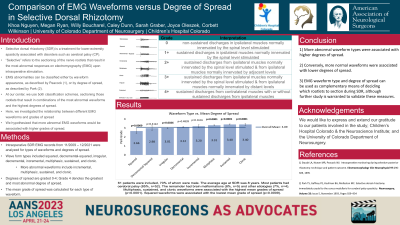Comparison of EMG Waveforms versus Degree of Spread in Selective Dorsal Rhizotomy
Friday, April 21, 2023


Corbett Corbett Wilkinson, MD, FAANS
Codirector, Surgical Tone/Rhizotomy Program
Department of Neurosurgery, Children's Hospital Colorado/University of Colorado School of Medicine
Aurora, Colorado, United States
ePoster Presenter(s)
Introduction: Selective dorsal rhizotomy (SDR) is a treatment for lower-extremity spasticity associated with disorders such as cerebral palsy (CP). The term “selective” refers to the sectioning of those nerve rootlets that result in the most abnormal responses on electromyography (EMG) upon intraoperative stimulation. EMG abnormalities can be classified either by the appearance of the waveforms, as described by Peacock, or by the degree of spread, as described by Park. At our center, we use both classification schemes. Here, we examine the relationship between different EMG waveforms and Park grades of spread.
Methods: Intraoperative SDR EMG records from November 2009 through December 2021 were analyzed for types of waveforms and degrees of spread. Waveform types included squared, decremental-squared, irregular, decremental, incremental, multiphasic, sustained, and clonic. Incremental, multiphasic, sustained, and clonic waveforms are considered more abnormal and rootlets displaying them upon stimulation are often sectioned during surgery. Grades of spread are scored 0-4, 4 being the most abnormal. The mean grade of spread was calculated for each type of waveform. We hypothesized that more abnormal EMG waveforms would be associated with higher grades of spread.
Results: 61 patients were included, 70% of whom were male. The average age at SDR was 8 years. Most patients had cerebral palsy (85%, n=52). The remainder had brain malformations (8%, n=5) and other etiologies (7%, n=4). Multiphasic, sustained, and clonic waveforms were associated with the highest mean grades of spread (p < 0.0001). Squared waveforms were associated with the lowest mean grade of spread (p=0.0009).
Conclusion : Multiphasic, sustained, and clonic waveforms had the highest mean degrees of spread on intraoperative EMG during SDR. Squared waveforms had the lowest mean degree of spread. EMG waveform type and degree of spread can be used as complementary means of deciding which rootlets to section during SDR.
Methods: Intraoperative SDR EMG records from November 2009 through December 2021 were analyzed for types of waveforms and degrees of spread. Waveform types included squared, decremental-squared, irregular, decremental, incremental, multiphasic, sustained, and clonic. Incremental, multiphasic, sustained, and clonic waveforms are considered more abnormal and rootlets displaying them upon stimulation are often sectioned during surgery. Grades of spread are scored 0-4, 4 being the most abnormal. The mean grade of spread was calculated for each type of waveform. We hypothesized that more abnormal EMG waveforms would be associated with higher grades of spread.
Results: 61 patients were included, 70% of whom were male. The average age at SDR was 8 years. Most patients had cerebral palsy (85%, n=52). The remainder had brain malformations (8%, n=5) and other etiologies (7%, n=4). Multiphasic, sustained, and clonic waveforms were associated with the highest mean grades of spread (p < 0.0001). Squared waveforms were associated with the lowest mean grade of spread (p=0.0009).
Conclusion : Multiphasic, sustained, and clonic waveforms had the highest mean degrees of spread on intraoperative EMG during SDR. Squared waveforms had the lowest mean degree of spread. EMG waveform type and degree of spread can be used as complementary means of deciding which rootlets to section during SDR.
